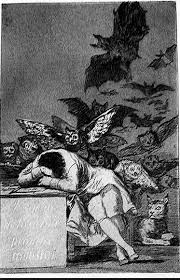Another crosspost from CLA, as are all the below--- Cat Lovers Almanac . One reason is I did not want to burden posts like below with philosophical stuff--- like that the analysis touches on what might be the basic question in the history of philosophy: the relation of words to ---- whatever. So, here's the post----
Francisco Goya has life span dates (March 30, 1746 to April 16, 1828) which are interestingly similar to those of William Blake (November 28, 1757 to August 12, 1827). I say interestingly since they are both the type of genius whose originality can still astound. There are of course other parallels, -- Shakespeare and Cervantes comes to mind; the effect can be that of something you think can be learned by the conjunctures, though conclusions never seem to eventuate. Goya was famous and mostly, paid; Blake not so much.
That Blake's cats are fewer than Goya's is merely of local interest. The cats below, Goya's, are models of the unsentimental. Here are two felines of Goya's which give us a sense of the expanse of his talent.
Here is a detail of a famous painting: titled Manuel Osorio Manrique de Zuñiga it was created between 1787 and 1788.

The whole painting can be seen here. Seeing the full canvas at the Met, or the link -- will allow you to glimpse a third cat.
And a decade later, here is a Goya etching from 1799. What a difference a French Revolution makes. Another detail actually, to emphasize the feline. This also famous rendering is titled: The Sleep of Reason Produces Monsters.

Both works of art together illustrate a refusal to lapse into sentimentality. Goya would not seek to please the princes, nor their usurpers. We see in the comparison a transition to greater specificity. Part of what the "sleep of reason" means is "hormones," though those concepts were not ones he used. Here is a picture of the full etching.

A wonderful thing about Goya is his pictorial analysis of the link between mind and body in this drawing.. You can see above the cats gradually turning into bats. The cats are what his contemporaries called, evil, what we call hormonal reality: the reason our actions don't match our words. The bats show the thoughts as they exist without daylight, logical constraints. No modern writer or painter I know of so lucidly connected mind and body as we see Francisco Goya did. No wonder some say modern art is a series of footnotes to Goya.
--
Francisco Goya has life span dates (March 30, 1746 to April 16, 1828) which are interestingly similar to those of William Blake (November 28, 1757 to August 12, 1827). I say interestingly since they are both the type of genius whose originality can still astound. There are of course other parallels, -- Shakespeare and Cervantes comes to mind; the effect can be that of something you think can be learned by the conjunctures, though conclusions never seem to eventuate. Goya was famous and mostly, paid; Blake not so much.
That Blake's cats are fewer than Goya's is merely of local interest. The cats below, Goya's, are models of the unsentimental. Here are two felines of Goya's which give us a sense of the expanse of his talent.
Here is a detail of a famous painting: titled Manuel Osorio Manrique de Zuñiga it was created between 1787 and 1788.

And a decade later, here is a Goya etching from 1799. What a difference a French Revolution makes. Another detail actually, to emphasize the feline. This also famous rendering is titled: The Sleep of Reason Produces Monsters.


--
Comments
Post a Comment